Contents
5. Jazz Theory
As mentioned earlier, the music of the American continent, already at dawn by the 19c, further evolved and mixed during the 20th century, giving birth to various new genres. Above all, it is crucial for the history of music theory that jazz was born and developed.
20c(2) : Jazz
Jazz came out as a result of mixing some genres in Southern America in late 19c and gained great popularity during 1920s.
Jazz was played in places like dance halls, which was the latest “dance music” for party animals at the time. But jazz, luckily or unluckily, also started to turn in the direction of more artistic performance, which eventually formed a genre called “Bebop” in 1940s, characterized by its intensive musicality and ad-lib improvisation.
“Improvisation” in this case doesn’t mean making a new song from scratch. Setting some existing song as a base, they arrange it or play some original melody line on it.
Here is the actual live performance. At first, the saxophonist (Charlie Parker) and the trumpeter (Dizzy Gillespie) are playing exactly the same phrase, and of course, this is not improvisation; it’s a set main theme. After that, each of them plays a solo, which is improvised. The accompanying musicians have roughly predetermined chords and rhythms to use, but it’s not completely specified in the sheet music; each individual arranges it on their own too.
Systems for Improvisation
In terms of complexity, contemporary classical music is certainly comparable with Bebop jazz. So what was revolutionary was definitely improvisation. Without detailed score, band members have to build music in harmony. You can easily imagine that the music would get in a chaotic mess, if the players play literally “freely”.
To what extent can it be arranged? How can you tell others what you’re going to play? Regarding these points, you won’t find answers to these questions no matter how many pages you flip through in classical theory books, where a perfectly planned composition is an undoubted premise. A brand new kind of music theory was strongly demanded among jazz players.
But there was inevitably a time lag from the emergence of the need to the formulation of the theory. It’s said that the publication of new theories specialized in jazz progressed around the 1950s-1960s1. The center of this development is the Eastern US, such as Boston or Ohio.
They drastically customized existing music theory to fit best to jazz, while inheriting many terms and concepts —Thus, the birth of a new music theory school : Jazz theory!!
In these books were many manners (guidelines) for improvisation to run smoothly, which are now often misunderstood as “rules of music“. Yeah, this is another “criminal” of why music theories are thought to have rules.
Late 20c : Jazz Going Artistic
While theorists were improving basic jazz theory, top artists moved forward and forward, going more and more artistic, seeking for new sounds.
No clear melody, no clear rhythm, diving into a world that was no longer understandable to the general public…Naturally, such jazz did not adhere to the modern jazz theory designed for the general audience; instead, it was built upon alternative methodologies they devised on their own.
Use conventional theory for conventional jazz, and use their original methods for their original jazz…This is quite similar to the movement we just saw in the classical musicd. Breaking established theory may be the nature of artists.
Late 20c : The “Pop Music”
As jazz became more complex and drifted away from the mainstream, its popularity shifted to other genres. And in the 1960s, the Beatles, iconic symbols of pop music, “invaded” the American charts. At the same time, music genres that remain popular today emerged one after another.
These are all 1960s songs. Hard rock, synth pop, reggae, funk, bossa nova, girl group…Though the recordings may sound a bit vintage, in terms of styles, instruments or formations they are the same as today’s pop music.
Pop Music Theory?
The origin of these pop music can be mainly traced back to 19-20c American music such as blues, gospel, folk, country, bla bla bla. Yes you can also confirm influences from classical music and jazz, but it’s not accurate to see these pop music as “direct descendant” of them.
So the theorists built a new theory by mixing the essence of all these various genres…? Oh, no, they didn’t.
There could be several of reasons for this e.g. Demand from musicians was not high, pop music were too versatile, or the old theories worked fine to some extent or whatever. Anyway unlike the era of jazz, the “third school” of music theory was not established.
After that a number of unconventional music were born. Above all, electronic music and hip-hop defined utterly different style for composition with new technologies and philosophy.
6. Two Major Schools
Finally, in music theory world there are two big rivers flowing : “Classical Harmony” and “Jazz Theory“.
So if you learn music theory, its contents are quite different according to which river you dive in. And both school also branch into various streams, furthermore, they are just theories for specific Western music in specific era.
Looking at it again, it’s really a discussion within a narrow world. Beyond this scope, there are plenty of music genres with their own unique theoretical frameworks. So, music theory is never just singular. “Music theory” is a collective term for various artificial systems that discuss certain ranges of music.
And since music is always evolving, it’s not surprising or unusual for music ignoring traditional theories to be favored in current music scene.
The Identity of “Rules”
Two “rules” are mentioned so far : (1)Those not regarded as “standard” in classical music, and (2)Those regarded as breach of “manners” in jazz improvisation.
Both prove effective only under specific situations. If you dare call them rules, they are “local” rules at its best. It’s much better to perceive them as “manners” or “formats” of a genre.
And since manners or formats differ between genres, if you’re in love with, let’s say rock or EDM, what they call “standards” or “guidelines” will be pointless to follow (more or less).
OK, that’s the end of our time-travel adventure! Long way you’ve been through but the value of reading through it is immense. You now completely grasp the very fundamentals of music theory.
- Music theory is not one. No single music theory is universal.
- The trends and styles of each era have always been reflected in music theory.
- Therefore you can switch between multiple theories according to what you compose.
- Artists always break rules, which results in the rise of new music.
- This cycle of creating new music and then theorizing it has been repeated.
This comprehension will prevent you from getting “suffocated” by music theory. But you’ve also witnessed that theorists kinda disregarded pop music after jazz…So the next, I’m gonna come on to a very sensitive topic — The uselessness of music theory.
Continue




